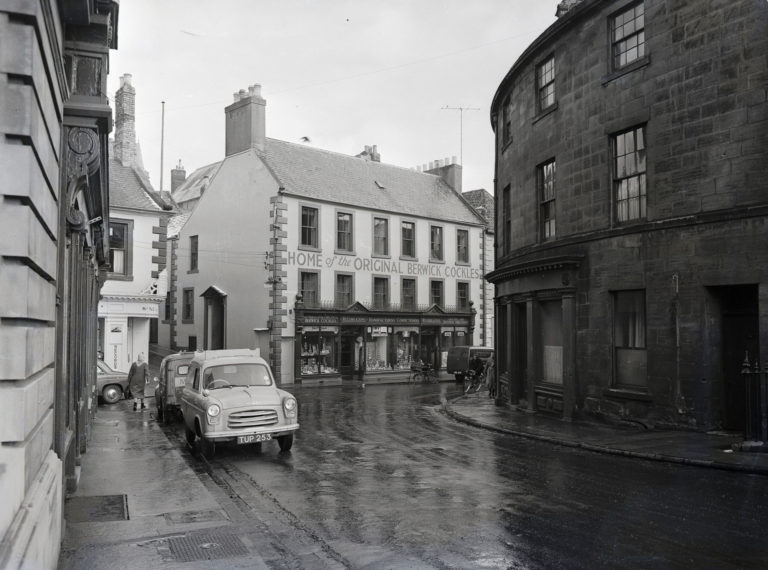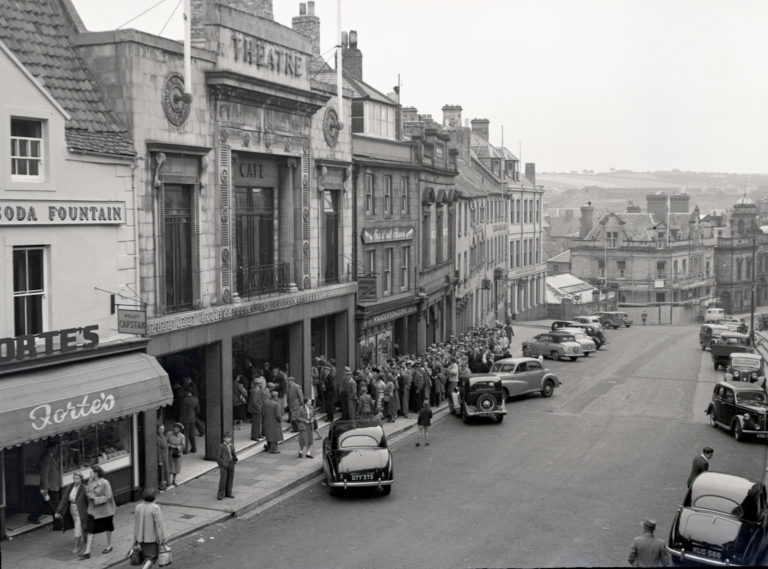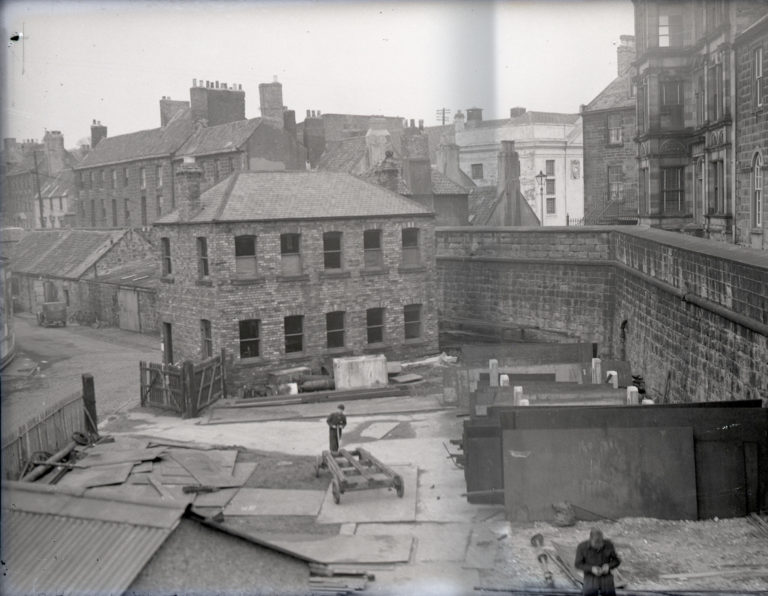Photographs of Building Exteriors, 1952 – 1964
Reference: BRO 1944/1/1872/11, BRO 1944/1/995/1, BRO
1944/1/4085/28, BRO 1944/1/253/5
Suggested age groups: KS2, KS3, KS4, KS5, Lifelong Learners
Topic areas: Photography, Architecture
CONTEXT
Originally founded in 1951 as the Photo-News Service, the Photo Centre in Berwick was a staple of town life for over 65 years as a family-run press agency and photo studio.
Their premises at 17 Bridge Street had a well-equipped studio above the shop where commercial photography took place. The business also covered newsworthy events in the area and recorded family occasions and celebrations, marking milestones in the lives of several generations of townspeople.
The first photograph (BRO 1944/1/1872/11) was taken in March 1958. It shows William Cowe and Son’s grocery store, the ‘Home of the Original Berwick Cockles’. ‘Cockles’ are a local peppermint sweet which had been made on the premises since 1801. The shop closed in 2010.
The second photograph (BRO 1944/1/995/1) was taken in August 1955 and shows a queue outside The Theatre in Hide Hill, waiting to see the British war film The Dam Busters. The Theatre advertised the “Northern Premier” from 25th August, and it was then kept on “owing to unprecedented demand”. The Dam Busters was the most popular film to be shown in British cinemas in 1955. The Theatre opened in February 1928 as Berwick’s second cinema. With dwindling cinema audiences in the 1960s, it closed at the beginning of 1969. Since then, it has had various uses including a bingo hall and restaurant.
The third photograph (BRO 1944/1/4085/28) was taken in September 1964 and shows Lamberton Toll House. Like the Blacksmith’s in Gretna Green, this was the scene of many marriages in the past. Until the late 19th century, “Irregular” or “Penny Marriages” were carried out by so-called priests just across the border in Scotland but were legally recognised in England. People would come from all over North Northumberland and further afield to get married there, some of them eloping. This house was demolished in 1975 when the A1 was widened.
The final photograph (BRO 1944/1/253/5), taken in 1952 shows Berwick Quayside shortly after shipbuilding had resumed on the site. On the right, steel sheets for ship hulls can be seen, held in place by “kickers”. The stores at the back left have now disappeared, but the square building in the centre still stands. At the back right, the Playhouse cinema is partially visible. After being unused for five years, it was demolished in November 2010 and has been replaced by a modern Premier Inn hotel.
Berwick-upon-Tweed is a town of contrasts. It has many old, listed buildings and structures dating back to the 16th century and before, including the remains of Berwick Castle, medieval fortifications, the iconic Tudor town walls, bridges, army barracks and the Town Hall. However, these are also many new 20th and 21st century structures including the Maltings Arts Centre (Eastern Lane), Premier Inn (Sandgate) and shops on Marygate including Boots. This has created a mix of old and new which sit side by side.
Until the early 20th century, most of the residential buildings in Berwick were concentrated within the Tudor Walls. However, many of them were in poor condition which led to overcrowded conditions with one family living in a couple of rooms. Many were pulled down in the 1930s and the residents were moved out to new modern properties on the edge of town.
By the 1970s, Berwick had the highest concentration of listed buildings in the country but 130 of them were either derelict or in a poor state of repair. This led to the establishment of the Berwick Preservation Trust in 1971 who purchased properties at risk, renovated and then often sold them to pay for future projects. The organisation has overseen the renovation of properties on Quay Walls, the Granary in Dewars Lane and Shoe Lane.
Until the 1960s, shops in Marygate and the centre of town were often small local businesses with their own identity. However from then on, many of the old premises were demolished or altered to look “modern”. This has created a very different “High Street” and town centre to the one which existed before this.
Berwick has a unique built heritage and often it is only by looking above eye level that people can appreciate and spot original historical features of what appears to be a modern building at ground level.
Exterior architecture photography covers photographs that primarily show the exterior of manmade structures. This could include houses and buildings, bridges, cityscapes, and other notable structures.
Urban Exploration photography (or Urbex photography) is a subfield of architecture photography. The main premise of Urbex photography is exploring old, lost, abandoned, and decaying locations and recording them with photography.
Some artists, such as Nicky Bird and Sarah Schönfeld work with photographs showing spaces in the past, and use either first-hand or collective memory of those who experienced the spaces to create new works reflecting on the evolution, destruction or reconstruction of locations over time.
ARTISTS BANK
Nicky Bird
Nicky Bird is a photographer and academic. Her work investigates the contemporary relevance of ‘found’ artefacts, their archives and specific sites through collaborative art processes with people who have significant connections to a latent history. Her series Beneath the Surface/Hidden Places (2007-2010) explored the physical and emotional effects of places in Scotland which had undergone significant change in recent memory.
Portfolio: https://nickybird.com/
Julia Solis
Julia Solis is a photographer and artist working with abandoned and subterranean urban spaces. Her ongoing performative series Dark Passages invites people to take part in performance-based scavenger hunts and parlour games in forgotten spaces. Her work aims to inspire people to create stories and relationships with ruined spaces. Julia also documents architectural decay.
Portfolio: http://solis.darkpassage.com/
Sarah Ancelle Schönfeld
Sarah Ancelle Schönfeld is a German visual artist. Sarah was 10 years old when the Berlin Wall fell. She returned to Lichtenberg, the neighbourhood where she grew up, as an adult and was shocked to find it disappearing. Her photographic series Childhood Memories Documented in Ruins documents the decline in the area.
Example series: Childhood Memories Documented in Ruins (2012)
Eugene Atget
Eugene Atget (1857-1927) was a photographer who lived and worked in Paris. From the 1880s until his death in 1927, Atget walked the streets in Paris and created a photographic urban diary documenting the city, capturing the living culture and history; noticing change; and recording the unique, quirky and mundane.
Portfolio: https://www.atgetphotography.com/
Camilo José Vergara
Camilo José Vergara has been documenting poor, urban and minority neighbourhoods across the United States since 1977. Vergara frequently returns to the same cities to photograph them over time. He describes himself as a historically conscious documentarian and an archivist of decline.
Portfolio: https://www.camilojosevergara.com/
ACTIVITIES
ACTIVITY 1
Background
Berwick-upon-Tweed is a town of contrasts. It has many old, listed buildings and structures dating back to the 16th century and before, including the remains of Berwick Castle, medieval fortifications, the iconic Tudor town walls, bridges, army barracks and the Town Hall. However, these are also many new 20th and 21st century structures including the Maltings Arts Centre (Eastern Lane), Premier Inn (Sandgate) and shops on Marygate including Boots. This has created a mix of old and new which sit side by side.
SEE
See: What buildings are shown in these photographs?
See: How many of these buildings still exist today?
See: When do some of the oldest structures in Berwick date from?
See: What are some of the oldest structures in Berwick?
See: What are some examples of structures built in Berwick during the 20th and 21st century?
THINK
Think: Why were many of Berwick’s old, listed buildings either derelict or in a poor state of repair?
Think: Why have so many of these buildings been demolished or repurposed?
Think: Should buildings with historic significance, such as the Lamberton Toll House be preserved?
Think: Does the demolition of buildings remove the cultural identity of a place?
Think: How have British high streets and town centres changed since the 1950s and 1960s?
Think: Why have British high streets and town centres changed since the 1950s and 1960s?
Think: Are the changes that have taken place for the better or for the worse?
Think: Where did most people shop during the 1950s and 1960s?
Think: Where do most people shop now?
Think: How much has your local area changed within your lifetime?
DO
Do: Use Google Street View, or visit if you are close to Berwick, look at the current day locations of each of these photographs. How much have they changed?
Do: Choose one of the locations from the photographs. Come up with a way to redesign the present-day location to celebrate what used to be there.
Do: Research the British high street. How has this changed since the 1950s/60s? What challenges and successes does it face today?
Do: Research brands and shops that emerged in Britain during this time. How many still exist today?
Do: Research your local high street and town centre. Can you find a list of which businesses were there during the 1950s/60s?
Do: Create a survey of the businesses from the 1950s/60s. What services did they provide? Were they local, national, or international businesses? How many stores were empty?
Do: Visit your local high street or town centre. Create a survey, when did each of the businesses open? Are any still there that were open during the 1950s/60s? What services do they provide? Are they local, national, or international businesses? How many stores are empty?
Do: Create a survey of the shops on your local high street. What services do they provide? How many are independent local shops and how many are national/international chain shops?
Do: Create charts comparing the two sets of data. You could repeat the activities for additional years to see a wider trend over time if you would like to.
Do: Use this data to write about how your local high street or town centre has changed between the 1950s/60s and today. Does this fit with the general trend of high streets in Britain? Can you use evidence to state why these changes might have taken place?
Do: Discuss the challenges faced by high streets today.
Do: Make a proposal of how British high streets and town centres could be revitalised.
Do: Research your local area. Can you find the oldest structures in your area? What condition are they in?
Do: Locate an old structure in your local area that is either derelict or in a poor state of repair. Come up with a proposal of how this structure could be renovated while maintaining its cultural heritage.
Resources
ACTIVITY 2
Background
Exterior architecture photography covers photographs that primarily show the exterior of manmade structures. This could include houses and buildings, bridges, cityscapes, and other notable structures.
Urban Exploration photography (or Urbex photography) is a subfield of architecture photography. The main premise of Urbex photography is exploring old, lost, abandoned, and decaying locations and recording them with photography.
SEE
See: What is exterior architecture photography?
See: What us Urban Exploration photography?
See: What type of photographs are these images?
See: How many of these buildings still exist?
See: Of those that still exist, how many of these buildings still have the same function?
THINK
Think: What is the purpose of architecture photography?
Think: What different styles of architecture photography are there?
Think: What is the purpose of these photographs?
Think: Why were these photographs taken and where might they have appeared?
Think: How are these photographs useful today?
Think: Is it important to document where we live?
Think: What are the characteristics of Urban Exploration photographs?
Think: What is the purpose of Urban Exploration photography?
Think: Why do people work with lost places as an artistic theme?
Think: Is it important to work with local communities on these types of projects?
Think: How can local communities be included in these types of projects?
DO
Do: Experiment with tilt shift. How can this alter the way that landscapes look?
Do: Research different exterior architecture photography artists with different styles. Make an annotated mood board with your research.
Do: Choose at least 3 different exterior architecture photographers with different styles. Create a shoot experimenting with each of these different styles.
Do: Create an annotated mood board with the results of each of your experimental style shoots. Analyse each style – which worked best, which was your favourite, what didn’t work and why?
Do: Plan and design your own exterior architecture shoot in a style of your choosing.
Do: Undertake your shoot and create a series of final images.
Do: Present and display your final images in a way that you think is appropriate.
Do: Evaluate your final images.
Do: Research different photographers and artists working with the themes of lost, abandoned, demolished, or regenerated places. Create a profile for each artist and their different style and approach to these themes.
Do: Research community engagement art, and how artists working with the themes of lost, abandoned, demolished, or regenerated places work with communities to create meaning and context for these places.
Do: Think about your local area. Can you identify any lost, abandoned, demolished, or regenerated places. This could be on a large or small scale.
Do: Plan a shoot based around the places you have identified. Think about how you can add meaning and context to the place.
Do: Consider how you could add community involvement into your shoot to add meaning and context. This could include interviews, recordings, elements of performance, collaborative making and so on.
Do: Undertake your shoot. Consider if your project will be solely photographic or if there will be other audio, visual, 3D or performance-based elements to your final piece.
Do: Produce your final piece.
Do: Present and display your final piece in a way that you think is appropriate.
Do: Evaluate your final outcome.
Resources
https://www.adobe.com/uk/creativecloud/photography/discover/architecture-photography.html
https://www.format.com/magazine/resources/photography/architecture-photography
https://bennatberger.medium.com/urban-diaries-documenting-cities-as-they-evolve-5010c586a9fb
https://expertphotography.com/urban-exploration-photography-tips/
https://www.obsidianurbexphotography.com/
https://www.tate.org.uk/art/art-terms/p/participatory-art
http://magazine.art21.org/2010/06/03/interactive-and-participatory-art/#.YYK4iL3P3DI
https://www.livablecities.org/blog/art-space-and-community-engagement
https://digital-photography-school.com/an-introduction-to-tilt-shift-photography/
OTHER ONLINE RESOURCES
Berwick Preservation Trust: https://berwickpreservationtrust.co.uk/
Facades of Berwick, 1959: https://www.flickr.com/photos/99322319@N07/albums/72157635294458489
Restoration of Georgian buildings in Berwick: https://www.crobertson.co.uk/conservation
Early Photography
Science Museum website, page about history of photography: https://www.scienceandmediamuseum.org.uk/objects-and-stories/history-photography
British Library website, page about invention of photograph (Henry Fox Talbot): https://www.bl.uk/collection-items/invention-of-photography
Bodleian website, biography of Henry Fox Talbot: https://talbot.bodleian.ox.ac.uk/talbot/biography/
Photo Centre
Portrait of a Town exhibition: https://www.photocentreberwick.co.uk/portrait-of-a-town/work-and-industry
Photo Centre workshop resources: https://www.photocentreberwick.co.uk/learning
Exterior architecture
Adobe guide to exterior architecture photography: https://www.adobe.com/uk/creativecloud/photography/discover/architecture-photography.html
Format guide to photographing architecture: https://www.format.com/magazine/resources/photography/architecture-photography
Photographing Lost Spaces and Changing Landscapes
Lost places exhibition: https://www.e-flux.com/announcements/34052/lost-places-sites-of-photography/
Article about photographing interiors of abandoned buildings: https://petapixel.com/2021/07/13/scientist-photographs-historically-rich-abandoned-and-forgotten-spaces/
Article about photographing lost areas of East Berlin: https://www.spiegel.de/international/zeitgeist/artists-photographs-disappearing-sites-of-her-childhood-in-eastern-germany-a-847651.html
Article about documenting changing cities: https://bennatberger.medium.com/urban-diaries-documenting-cities-as-they-evolve-5010c586a9fb
Urban Exploration: https://expertphotography.com/urban-exploration-photography-tips/
Obsidian Urbex Photography: https://www.obsidianurbexphotography.com/





